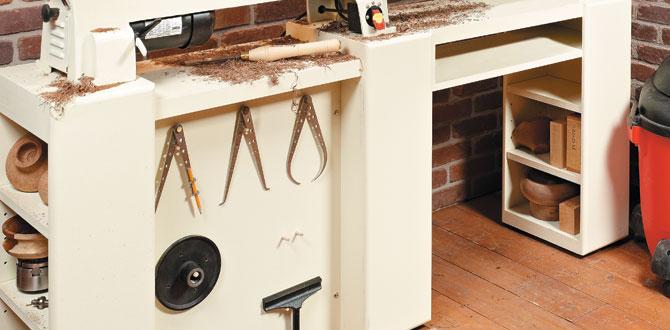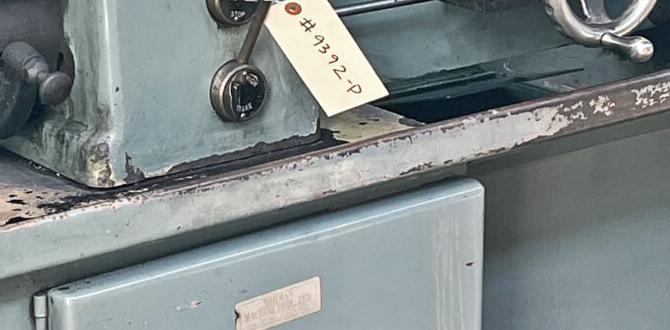Quick Summary
A Tialn ball nose end mill with a 40-degree helix angle is a reliable choice for machining PEEK slots. Its specialized design offers superior chip evacuation and reduced heat buildup, crucial for this challenging, gummy plastic. This guide explains why and how to use it effectively for consistently good results.
Tired of struggling to mill precise slots in PEEK? You’re not alone. PEEK, a super-strong, high-performance plastic, can be notoriously difficult to machine. It tends to melt and gum up, leading to poor surface finish and broken tools. But there’s a specific tool that makes this job much easier: the Tialn ball nose end mill with a 40-degree helix angle.
This specialized end mill is designed to tackle the unique challenges of PEEK. We’ll dive into exactly why it’s so effective and walk you through how to use it safely and efficiently. Get ready to mill those deep, clean PEEK slots with confidence!
Why a 40-Degree Helix Ball Nose End Mill for PEEK?
When you’re working with advanced materials like PEEK, your standard tooling might not cut it. PEEK stands for Polyetheretherketone, and it’s loved for its incredible strength, chemical resistance, and high-temperature performance. All these great qualities make it a machining headache. It’s a bit like trying to cut through tough cheese that likes to melt – it wants to stick to the tool and create a mess.
This is precisely where a Tialn ball nose end mill with a 40-degree helix angle shines. Let’s break down the key features that make it a champion for PEEK slots:
The Ball Nose Advantage
First, the “ball nose” shape. Unlike a standard flat-bottom end mill, a ball nose has a rounded tip. This is perfect for milling slots because:
Smooth Transitions: The rounded tip creates a smooth fillet (curve) at the bottom of the slot, which is often desirable for stress distribution and preventing cracks.
No Center Drag: A flat end mill trying to plunge into material can sometimes “drag” its center point, causing chatter and a rough finish, especially in plastics that heat up easily. The ball nose avoids this issue.
Versatility: While we’re focusing on slots, ball nose end mills are also great for contouring and creating round features.
The Importance of the 40-Degree Helix Angle
Now, the “40-degree helix angle” is where the magic really happens for PEEK. The helix angle is the angle of the flutes (the spiral cutting edges) around the tool. A steeper helix angle means the flutes are more tightly wound.
Here’s why 40 degrees is a sweet spot for PEEK:
Superior Chip Evacuation: PEEK, when cut, creates long, stringy chips. A steeper helix angle like 40 degrees helps to “lift” and “throw” these chips away from the cutting zone more effectively. This prevents chips from building up, which is a primary cause of overheating and tool breakage in PEEK.
Reduced Heat Buildup: Good chip evacuation directly leads to less heat. When chips get stuck, they act like an insulator, trapping heat generated by the friction of cutting. High heat is PEEK’s enemy, making it soft, sticky, and difficult to machine. The 40-degree helix helps keep things cooler.
Smoother Cutting Action: The steeper angle also contributes to a more shearing action, which can result in a cleaner cut and a better surface finish on the plastic.
Tialn Coating for Durability: The “Tialn” in Tialn ball nose end mill refers to a Titanium Aluminum Nitride (TiAlN) coating. This is a very hard, wear-resistant coating that further protects the tool from heat and abrasion. It’s like giving your end mill a tiny, super-tough suit of armor, extending its life significantly, especially in demanding materials like PEEK.
What About Other Helix Angles?
You might see end mills with different helix angles, like 30 degrees or 45+ degrees.
Lower Helix Angles (e.g., 30 degrees): These are generally better for softer materials or when you need a more aggressive cut but might struggle with chip evacuation in gummy materials.
Higher Helix Angles (e.g., 45+ degrees): While offering even better chip evacuation, they can sometimes lead to increased tool pressure and chatter if not used with the right settings.
The 40-degree angle often strikes the ideal balance for PEEK, providing efficient chip removal without demanding excessive rigidity from your machine.
Selecting the Right Tialn Ball Nose End Mill
Choosing the correct tool is the first step to success. For PEEK slots, consider these factors:
Diameter
The diameter of the ball nose end mill will determine the radius of the fillet at the bottom of your slot. For a specific slot width, you’ll need to select a diameter that allows for the desired radius. For example, if you need a slot 0.250 inches wide with a 0.125-inch radius at the bottom, a 0.250-inch diameter ball nose end mill is perfect (radius = diameter / 2).
Length of Cut (LOC)
This is how much of the tool’s cutting length is available. Make sure the LOC is sufficient for the depth of the slot you need to mill. It’s generally better to have more LOC than you strictly need, as it provides more flexibility.
Overall Length (OAL)
The total length of the tool. This is less critical for slotting but ensures the tool holder can grip the shank adequately.
Number of Flutes
Ball nose end mills for plastics typically come with 2 or 3 flutes.
2 Flutes: Generally offer better chip clearance and are often preferred for plastics like PEEK. They also reduce the chance of rubbing and overheating.
3 Flutes: Can sometimes provide a smoother finish but might be more prone to clogging with gummy materials if chip evacuation isn’t ideal.
For PEEK, a 2-flute, 40-degree helix Tialn ball nose end mill is often the go-to choice.
Material and Coating
As we discussed, the Tialn (TiAlN) coating is essential for its heat resistance and durability in demanding applications. The tool itself is usually made from high-quality solid carbide, which is hard and maintains its edge.
Example Tool Specification:
Here’s what a typical product listing might look like:
| Feature | Specification |
| :—————— | :——————————————- |
| Type | Ball Nose End Mill |
| Coating | Tialn (TiAlN) |
| Helix Angle | 40 Degrees |
| Number of Flutes | 2 |
| Material | Solid Carbide |
| Diameter (D) | 0.250 inches (6.35 mm) |
| Radius (R) | 0.125 inches (3.175 mm) |
| Length of Cut (LOC) | 0.750 inches (19.05 mm) |
| Shank Diameter | 0.250 inches (6.35 mm) |
| Overall Length (OAL)| 2.5 inches (63.5 mm) |
Remember to always double-check the exact specifications when purchasing.
Setting Up Your Machine and Tooling
Proper setup is critical for safe and effective machining.
Machine Rigidity
PEEK can be tough. Ensure your milling machine is rigid and well-maintained. Any looseness in the spindle, table, or ways will translate into chatter and poor surface finish. For hobbyist machines, consider using techniques to improve rigidity where possible.
Tool Holder
Use a high-quality tool holder. For end mills, a collet chuck or a dedicated end mill holder is recommended. Aim for holders that provide good runout (the wobbling of the tool). Low runout is essential for a clean cut.
Workholding
Secure your PEEK workpiece firmly. Use clamps or a vise that won’t distort the plastic. Avoid overtightening, as PEEK can be deformable. Ensure the workpiece is flat and stable.
Coolant/Lubrication
This is a crucial point for PEEK. While some plastics can be machined dry, PEEK benefits greatly from a coolant or lubricant.
Flood Coolant: If your machine supports it, a flood coolant system is ideal. It washes away chips and keeps temperatures down.
Mist Coolant/Lubrication: A mist system that sprays a fine atomized coolant and air mixture onto the cutting zone is very effective for PEEK.
Lubricant Stick or Fluid: For smaller jobs or machines without advanced coolant systems, you can use a specialized plastic machining lubricant stick or a light-duty cutting fluid applied manually. Never use compressed air alone, as it will just blow hot chips around and potentially melt the plastic without cooling.
Look for lubricants specifically designed for machining plastics, as they often have properties that prevent gumming. Some machinists use a light oil like WD-40 for very light cuts, but a dedicated plastic lubricant is usually better. For more information on safe machining practices and coolants, resources like the Occupational Safety and Health Administration (OSHA) standards for machine guarding (though not specific to PEEK, it covers general machine safety) can be informative regarding machine setup and safety.
Zeroing Your Tool
Carefully set your X, Y, and Z zero points. For the Z-axis, it’s best to use a Z-probe or a touch-off tool to ensure accuracy.
Machining Parameters for PEEK Slots
Finding the right settings – speed, feed, and depth of cut – is key to a successful PEEK slotting operation. These are starting points, and you’ll likely need to dial them in based on your specific machine, tool, and the exact grade of PEEK.
Surface Speed (SFM/Vf)
PEEK is sensitive to heat. You need to balance cutting speed with feed rate to manage chip load and heat. A good starting point for PEEK with carbide tools is often in the range of 200-500 surface feet per minute (SFM). Your machine’s controller might use a spindle speed (RPM).
The relationship is:
$SFM = (RPM × pi × Diameter) / 12$
So, to find RPM you can rearrange it:
$RPM = (SFM × 12) / (pi × Diameter)$
For a 0.250 inch diameter end mill at 300 SFM:
$RPM = (300 × 12) / (pi × 0.250) approx 4584$ RPM
Let’s use a round number like 4500 RPM to start.
Feed Rate (IPM)
The feed rate is how fast the tool moves into the material. This is critical for controlling chip load. For plastics like PEEK, you generally want a relatively light chip load to avoid excessive heat and stress as you cut.
Chip load is the thickness of the material removed by each cutting edge per revolution.
$Chip Load = Feed Rate / (RPM × Number of Flutes)$
A good starting chip load for PEEK with a 0.250″ ball nose end mill might be between 0.001″ and 0.003″ per flute.
Let’s calculate feed rate based on our 4500 RPM and a chip load of 0.002″ per flute (2 flutes):
$Feed Rate = Chip Load × RPM × Number of Flutes$
$Feed Rate = 0.002″ × 4500 × 2 = 18$ inches per minute (IPM)
So, a starting point could be:
Spindle Speed: 4500 RPM
Feed Rate: 18 IPM
Depth of Cut (DOC)
This is how deep you cut on each pass. For machining PEEK, especially in slots, it’s best to take lighter, shallower passes rather than one deep cut. This lets the tool and coolant do their job more effectively and reduces the risk of overheating or tool breakage.
Per Pass Radial Depth (Stepover): When milling a slot wider than your tool, this is how much you move sideways. For PEEK, this is usually not an issue when milling a slot with the correct diameter tool.
Per Pass Axial Depth (Depth of Cut): For a slot, this is how deep you cut down into the material on each depth increment. Aim for a maximum axial depth of cut of about 0.050″ to 0.100″ per pass. It’s much better to make 10 passes at 0.100″ than one pass at 1.000″ for a deep slot.
Example Cutting Parameters Table
Here’s a table summarizing aggressive but generally safe starting parameters for a 0.250″ diameter Tialn 40-degree helix ball nose end mill in PEEK:
| Parameter | Recommended Value | Notes |
| :———————- | :—————— | :——————————————————————————————————- |
| Material | PEEK | |
| Tool | 0.250″ Tialn Ball Nose End Mill, 40-deg Helix, 2 Flute, Carbide | |
| Spindle Speed (RPM) | 4000 – 5000 RPM | Adjust based on tool cooling and sound. |
| Feed Rate (IPM) | 15 – 25 IPM | Adjust to maintain a light chip load (0.0015″ – 0.003″ per flute). Listen for rubbing vs. cutting sound. |
| Axial Depth of Cut | 0.050″ – 0.100″ | Take multiple shallow passes rather than one deep cut. |
| Coolant/Lubrication | Essential | Flood, mist, or specialized lubricant. Never dry. |
| Rigidity | High | Ensure machine and workholding are stable. |
Important Considerations:
Listen to Your Cut: The best indicator is the sound. A clean, crisp cutting sound is good. A squealing or rubbing sound means too much friction, likely too high speed, too high feed, or not enough coolant. A loud “thwacking” sound might indicate your feed rate is too high or you’re taking too deep a cut.
Observe the Chips: Chips should be well-formed and easily cleared. If they are melting, stringy, or sticking to the tool, adjust your parameters (increase feed, decrease speed, increase coolant).
Start Conservatively: It’s always safer to start with slightly more conservative parameters and increase them if the cut is going well, rather than starting too aggressively and breaking a tool.
PEEK Grades Vary: Different grades of PEEK can have slightly different machining characteristics.
Using a CNC mill offers the most control over these parameters. For manual milling, you’ll need to employ careful hand-feeding techniques, relying even more on sound and visuals.
Step-by-Step Guide to Milling PEEK Slots
Let’s put it all together into a practical process.
Step 1: Prepare Your Workpiece and Machine
1. Secure the PEEK: Clamp or vise your PEEK workpiece firmly but without deforming it. Ensure it’s flat against the machine table.
2. Ensure Stability: Check that your machine’s spindle, table, and any moving parts feel solid and have no play.
3. Install Tooling: Insert your Tialn 40-degree helix ball nose end mill into a clean, high-quality tool holder. Mount the holder securely in the machine spindle.
4. Set Up Coolant: Ensure your coolant system is ready to go. If using a spray or stick, have it within easy reach without compromising safety.
Step 2: Set Up Your Program (CNC) or Establish Zero (Manual)
CNC: Load your G-code program. Double-check your tool definition in the control.
Manual: Carefully touch off your tool on the workpiece to establish your X, Y, and Z zero points. Use a touch-off plate or a precision edge finder for accuracy. Ensure your Z-zero is precisely at the top surface of your workpiece where you want to start cutting.
Step 3: Single Block Through the First Cut (CNC) or Manual Feed
CNC: Run the program in single-block mode (one block of code at a time). Watch as the tool approaches the workpiece. Ensure the entry into the material is correct.
Manual: Carefully bring the spinning tool down to the Z zero point and begin feeding into the material using your handwheel or lever.
Step 4: Make the First Pass
1. Initiate the Cut: Start the spindle and begin cutting according to your programmed feed rate or carefully hand-feed.
2. Engage Coolant: Turn on your coolant system or apply lubricant immediately as the tool begins to cut.
3. Observe the Sound: Listen attentively for the cutting sound. It should be a crisp, clean sound.
4. Monitor Chips: Watch the chips being produced. They should be relatively small and clear easily.
5. Check for Heat: While trickier to gauge quickly, avoid an immediate buildup of visible heat or melting plastic.
Step 5: Mill the Slot to Depth
1. **Depth







